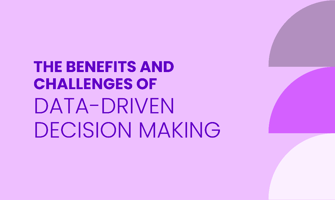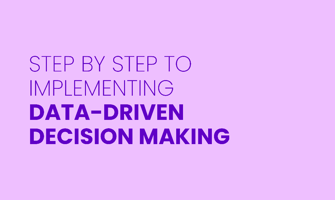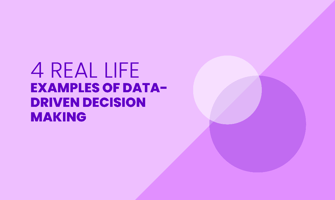Data-driven decision making (DDDM) has gained a lot of traction in the business world under the...
What is Data-Driven Decision Making?
Data-driven decision-making (DDDM) is a practical approach that involves making decisions based on actual data rather than intuition or observation alone. In the world where data is becoming more accessible and abundant, DDDM has become an essential part of successful business operations.
Unlike intuition-based decision-making which relies heavily on personal experience and gut feelings, DDDM provides a more objective basis for decisions. It takes into account hard facts gathered from various sources to make informed choices that can drive success in different areas of business.
In this article, we will take you through the basics of data-driven decision-making - what it means, why it's important in today's context, how it differs from other forms of decision making and its key components.
The Role of Data in Modern Business
Data touches every aspect of an organization, from marketing to operations, human resources to finance. In a business setting, data serves as a crucial resource that provides insights and supports strategic planning.
Today when information is at our fingertips, businesses are shifting their decision-making strategies. They're moving away from decisions based on 'gut-feeling' or intuition and leaning towards data-backed strategies. This shift allows for more informed decisions that can improve operational efficiency and drive growth.
The use of data isn't limited to one area within an organization either; it permeates all units - from top-level strategy formulation right down to daily operational tasks. When each unit adopts a culture centered around using reliable data for key decisions, they contribute collectively towards achieving overall business objectives.
Being 'data-driven' doesn't just mean having access to lots of numbers and figures; it means using those numbers effectively across different facets within your organization - essentially creating what we call a 'data-driven culture'.
Data-Driven Decision Making Briefly Explained
Data-driven decision-making (DDDM) is a method that businesses use to make strategic decisions based on facts, metrics, and data. It's not about guessing or going with your gut feeling. Instead, it's about using concrete information to guide your business choices.
The process of DDDM starts with data collection. Businesses gather relevant information from various sources such as customer feedback surveys, sales reports, and market research studies. This raw data is then processed and organized for analysis.
Next comes the stage of data analysis where statistical tools are used to understand patterns and trends in the collected data. Analysts examine this information carefully to extract meaningful insights that can inform decision-making processes.
Once these insights have been derived from the analysis phase, they are put into action through decision implementation. Here’s where businesses apply what they've learned from their analytics into practical steps toward achieving their goals.
What sets DDDM apart is its objective nature which helps reduce biases in business decisions - you're relying on real-world evidence rather than personal opinions or assumptions.
By incorporating DDDM into your operations strategy you'll be able to make more informed decisions that align better with your company objectives while also reducing risks associated with guesswork or speculation.
Benefits of Data-Driven Decision Making
The shift towards data-driven decision making (DDDM) has brought about a multitude of benefits for businesses. For starters, it improves efficiency by enabling organizations to make quicker and more accurate decisions based on real-time data. No longer do you have to rely on guesswork or hunches; with DDDM, your decisions are backed by solid evidence.
Another significant benefit is cost-effectiveness. By using data to guide your business strategies, you can allocate resources more efficiently and avoid costly mistakes that could hurt your bottom line.
Moreover, DDDM allows businesses to be more responsive to market trends and consumer behavior. With access to relevant data at their fingertips, companies can anticipate changes in the marketplace and adjust their strategies accordingly.
Risk management also gets a boost from DDDM through predictive analytics. This approach uses historical data patterns to predict future outcomes - an invaluable tool when planning for potential risks or opportunities.
For some concrete examples of how these benefits play out in real-world scenarios, check out these Real Life Examples of Data-Driven Decision Making. You'll see firsthand how improved efficiency, accuracy, enhanced risk management, and other advantages translate into tangible results for different types of businesses.
Lastly but importantly is the power that comes from informed decisions made possible by insights derived from collected data. The ability to not just collect but also interpret this information effectively means you're always one step ahead in understanding what's best for both your company as well as its consumers.
Components of Data-Driven Decision Making
1. Data Collection
Introduction to Data Collection
Data collection is a critical first step in the process of data-driven decision-making (DDDM). It involves gathering relevant information from various sources that can help your business make informed decisions.
The types of data collected can be broadly categorized into two: qualitative and quantitative. Qualitative data provides insights into opinions, attitudes, and behaviors, while quantitative data offers hard numbers for statistical analysis.
Best Practices in Data Collection
When collecting data for DDDM, it's crucial to have clear objectives in mind. Knowing what you want to achieve with the collected information helps guide your efforts toward obtaining the most relevant pieces of information.
Moreover, quality should always take precedence over quantity when it comes to collecting data. Having vast amounts of irrelevant or low-quality info won't do much good for your decision-making process; instead, focus on gathering high-quality and pertinent details that directly contribute towards achieving your goals.
In conclusion:
Identify reliable data sources
Understand both qualitative and quantitative aspects.
Set clear objectives before starting the collection process.
Prioritize quality over quantity during collection.
These key points are essential components of effective DDDM practices within any organization aiming at adapting a data-driven culture.
2. Data Analysis
Introduction to Data Analysis
Data analysis is a critical part of decision-making in businesses. It involves examining collected data sets to draw conclusions that can guide business decisions.
Data analysis, in the context of decision-making, refers to the process where raw data is cleaned, transformed, and modeled with the aim of discovering useful information for business decisions. Techniques commonly used include statistical methods and algorithms which help identify patterns or trends within large volumes of data.
Best Practices in Data Analysis
Accurate tools and techniques are essential when it comes to analyzing your data effectively. Tools like Tableau have become popular due to their ability to handle vast amounts of information while providing clear visualizations that make interpreting results easier.
But having great tools isn't enough on its own - you also need people who know how to use them correctly. That's why training for analysts is so important; they need a solid understanding not just about how these reporting tools work but also about what the results mean for your organization as a whole.
Remember, making sense out of complex datasets requires more than just technical skills – it requires knowledge about your specific industry too so you can interpret findings accurately and apply them effectively within your unique business context.
3. Data Interpretation
Introduction to Data Interpretation
Data interpretation is a critical step in the data-driven decision-making process. It's about making sense of the information that has been collected and analyzed, turning raw numbers into meaningful insights.
In the context of DDDM, data interpretation involves understanding what your analysis results mean for your business. It's not just about looking at figures or charts; it's about drawing conclusions from them that can guide your decisions.
Interpreting large sets of data can be challenging. With so much information available, it can be hard to know where to start or what to focus on. However, effective interpretation is essential if you want to make informed decisions based on solid evidence rather than guesswork.
Best Practices in Data Interpretation
There are several techniques you can use for effective data interpretation:
Use visualization tools: These help you see patterns and trends more clearly.
Understand the context: Don't look at numbers in isolation - consider how they relate to other factors affecting your business.
Ask questions: If something doesn't make sense or seems surprising, dig deeper until you understand why.
Remember that interpreting data isn't just a task for analysts or statisticians - everyone involved in decision-making should have some level of understanding when it comes down to this important component within DDDM framework.
4. Decision Implementation
Introduction to Decision Implementation
Decision implementation is the final stage in the data-driven decision-making process. It's where all the insights gained from data collection, analysis, and interpretation are put into action.
Implementing decisions within a data-driven framework involves taking concrete steps based on insights derived from analyzed data. This phase goes beyond merely making a choice; it includes setting actions into motion that align with these choices.
For instance, if your business analytics indicate an emerging trend among your customers' buying habits, you might decide to launch a new product line or offer special discounts to capitalize on this trend. The actual introduction of these changes in your operations represents decision implementation.
Best Practices in Decision Implementation
Aligning decisions with overall business objectives is crucial during decision implementation. For example, if one of your primary goals is customer satisfaction and you've gathered feedback indicating dissatisfaction with delivery timescales - implementing faster shipping options would be an aligned strategic move.
Feedback loops also play an essential role here as they allow for continuous refinement of implemented decisions based on ongoing results and new information collected over time. So even after implementing a decision, businesses should continue monitoring its impact through key performance indicators (KPIs) and other metrics relevant to their specific context.
In conclusion: Strategy forms the basis for action plans while feedback loops ensure adjustments can be made when necessary – both critical elements when it comes to effective decision implementation.
Tools and Technologies for Data-Driven Decision Making
Data-driven decision-making (DDDM) is a complex process that requires the right tools and technologies to handle, analyze, and interpret large volumes of data. The digital age has given rise to numerous solutions designed specifically for this purpose.
Firstly, there are database management systems like SQL Server or Oracle Database that help in storing and managing vast amounts of data. These systems provide a structured way to organize information so it can be easily accessed when needed.
Next up are analytics platforms such as Google Analytics or Tableau. They allow businesses to sift through their collected data efficiently, uncovering patterns and trends that may not have been immediately apparent otherwise. This ability is crucial in turning raw numbers into actionable insights.
For those dealing with big data - extremely large datasets that traditional software struggles with - specialized tools like Hadoop or Spark come into play. They're designed to process huge quantities of information quickly, enabling companies like Amazon or Google to make decisions based on real-time analysis.
Lastly, artificial intelligence (AI) plays an increasingly important role in DDDM by automating tasks such as predictive modeling or customer segmentation which would otherwise require significant time investment from human analysts.
To learn more about these tools check out our review of tools for data-driven decision making. And if you're interested in how these play a part in implementing DDDM within your organization take a look at Implementing Data-Driven Decision Making.
Remember though: while having the right technology is important it's just one piece of the puzzle. Successful DDDM also requires a clear strategy along with skilled personnel who know how best to use these resources.
Key Business Areas for DDDM
Data-Driven Decision Making (DDDM) is not limited to a single business area. It can be effectively applied across various domains, significantly enhancing their performance and outcomes.
One of the key areas where DDDM shines is marketing. With data-driven strategies in place, businesses can tailor their campaigns more accurately based on customer behavior patterns and preferences.
This approach allows companies to reach out to their target audience with pinpoint precision, thereby increasing engagement rates and ROI. If you're interested in learning more about this application of DDDM, feel free to check our guide on Data-Driven Marketing.
Customer success is another critical domain that benefits immensely from DDDM. By analyzing customer interactions and feedback, organizations can make informed decisions aimed at improving user experience and satisfaction levels. To get an idea about how it works in practice, take a look at our article discussing data-driven decisions for customer success.
Sales strategies also gain substantial advantages when driven by data insights rather than intuition or guesswork alone. A well-executed data-driven sales strategy helps identify potential leads faster while ensuring resources are utilized efficiently throughout the sales funnel process. You might find our piece on data-driven sales strategies helpful.
In essence, whether it's marketing efforts or aiming for better customer success results, or even fine-tuning your sales tactics - incorporating Data-Driven Decision Making into these crucial business areas will undoubtedly lead to enhanced efficiency and effectiveness.
Main Practical Challenges in Data-Driven Decision Making
While data-driven decision-making (DDDM) can offer significant benefits, it's not without its challenges. One of the most common obstacles businesses face is ensuring data quality. Without accurate and reliable data, any decisions made could lead to detrimental outcomes.
Data silos are another hurdle that organizations often encounter. When information is isolated within different departments or systems, it becomes difficult to get a comprehensive view of the business situation. This fragmentation can hinder effective decision-making processes.
Resistance to change also poses a challenge in implementing DDDM. People may be hesitant to shift from traditional methods they're comfortable with towards a more analytical approach based on hard facts and figures.
In addition, ethical considerations come into play when dealing with large amounts of personal customer data for analysis purposes. Businesses must ensure they respect privacy laws and handle sensitive information responsibly while using it for strategic planning.
The future promises even more complexities as real-time analytics become increasingly prevalent. As we move forward into an era where decisions need instant backing by up-to-the-minute data, businesses will have to find ways around these issues if they want their DDDM strategies to succeed.
Lastly but importantly is the issue of improving overall 'data literacy' among employees across all levels in an organization - everyone needs some level of understanding about how their role interacts with and impacts company-wide metrics.
Although there are several challenges involved in adopting DDDM practices effectively within an organization – including
Technical issues like maintaining high-quality datasets free from errors or inconsistencies.
Breaking down internal barriers preventing access between different parts our system; managing resistance against changing established routines.
Dealing responsibly with ethical concerns around privacy rights; and increasing overall levels of data literacy – these are all surmountable with the right approach, tools, and commitment.
Conclusion
Data-driven decision-making, or DDDM, is a significant factor in the modern business world. The use of data to guide decisions can lead to improved efficiency and accuracy while reducing costs. Businesses that adopt this approach are more responsive to market trends and consumer behavior.
One of the key benefits of DDDM is its ability to enhance risk management through predictive analytics. By using data effectively, businesses can make informed decisions that have a positive impact on their operations.
However, adopting a data-centric approach requires understanding and addressing several challenges such as ensuring data quality, breaking down data silos within an organization, overcoming resistance from employees who may be used to traditional methods of decision making, and navigating ethical considerations around privacy.
Despite these challenges though, the potential benefits far outweigh any hurdles faced during implementation. In summary, data-driven decision-making isn't just about numbers; it's about using those numbers intelligently for strategic planning and operational efficiency.
We at 180ops understand how important it is for businesses today to harness the power of their own information in order to make better-informed choices - which ultimately leads towards success both now and into the future. If you are interested in making your operations more data-driven, book a demo for our revenue intelligence tool.
FAQ
How can data-driven decision-making benefit agile businesses and e-commerce companies?
Data-driven decision making enables agile businesses and e-commerce companies to rapidly respond to market trends, customer behaviors, and operational efficiencies. By leveraging real-time data, these companies can optimize marketing strategies, improve customer service, and streamline supply chain operations, thus enhancing overall competitiveness and profitability.
How do decision-making tools and data visualization enhance the decision-making process in finance and transportation sectors?
In the finance and transportation sectors, decision-making tools and data visualization help in interpreting complex datasets, forecasting trends, and identifying risks effectively. This supports quicker, more informed decisions about asset management, investment strategies, logistical planning, and route optimizations.
How does biases in data-driven decision-making impact company processes?
Biases in data-driven decision making can lead to skewed outcomes, misinformed strategies, and ineffective policies that might harm a company’s operational and financial health. These biases can distort customer insights, risk assessments, and performance metrics, potentially leading to decreased customer satisfaction and operational inefficiencies.
How do I integrate new data sources into my existing data-driven decision framework?
To integrate new data sources, first assess the compatibility and quality of the data. Ensure proper data cleaning and processing methodologies are in place. Update your data models and algorithms to incorporate new variables. Regularly test and validate the augmented framework to ensure reliability and accuracy in your decision-making processes.
What role does reporting software play in tracking and achieving measurable goals through data-driven decisions?
Reporting software is crucial for monitoring performance indicators against measurable goals in a data-driven decision framework. It enables organizations to visualize progress, analyze trends, and adjust strategies in real-time. Effective reporting provides actionable insights that help in refining processes, optimizing resource allocation, and achieving targeted outcomes efficiently.




